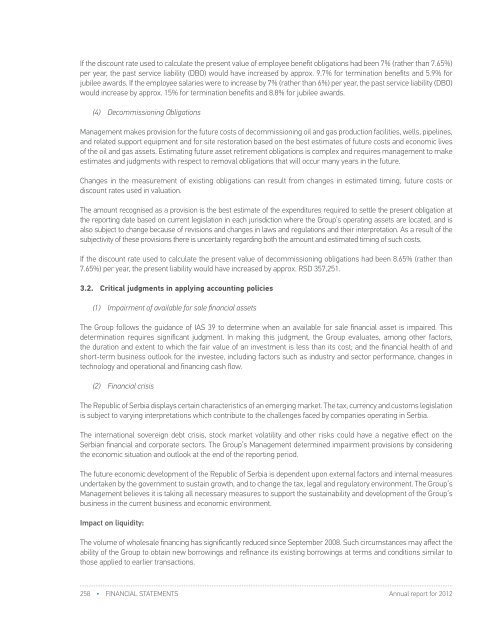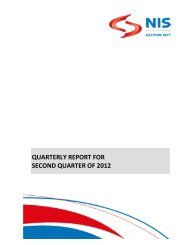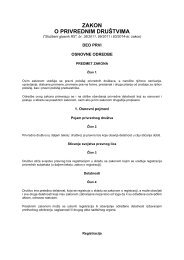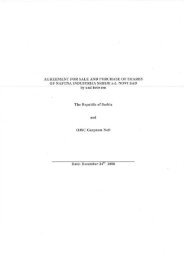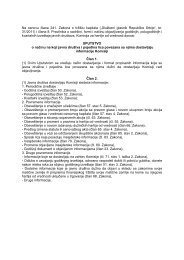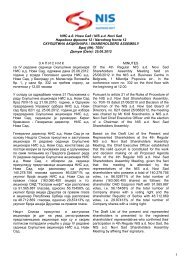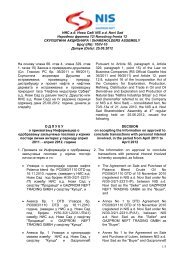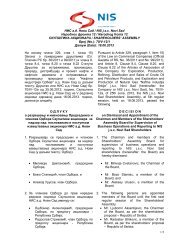FY 2012 - Investor Relations - NIS
FY 2012 - Investor Relations - NIS
FY 2012 - Investor Relations - NIS
Create successful ePaper yourself
Turn your PDF publications into a flip-book with our unique Google optimized e-Paper software.
If the discount rate used to calculate the present value of employee benefit obligations had been 7% (rather than 7.65%)per year, the past service liability (DBO) would have increased by approx. 9.7% for termination benefits and 5.9% forjubilee awards. If the employee salaries were to increase by 7% (rather than 6%) per year, the past service liability (DBO)would increase by approx. 15% for termination benefits and 8.8% for jubilee awards.(4) Decommissioning ObligationsManagement makes provision for the future costs of decommissioning oil and gas production facilities, wells, pipelines,and related support equipment and for site restoration based on the best estimates of future costs and economic livesof the oil and gas assets. Estimating future asset retirement obligations is complex and requires management to makeestimates and judgments with respect to removal obligations that will occur many years in the future.Changes in the measurement of existing obligations can result from changes in estimated timing, future costs ordiscount rates used in valuation.The amount recognised as a provision is the best estimate of the expenditures required to settle the present obligation atthe reporting date based on current legislation in each jurisdiction where the Group’s operating assets are located, and isalso subject to change because of revisions and changes in laws and regulations and their interpretation. As a result of thesubjectivity of these provisions there is uncertainty regarding both the amount and estimated timing of such costs.If the discount rate used to calculate the present value of decommissioning obligations had been 8.65% (rather than7.65%) per year, the present liability would have increased by approx. RSD 357,251.3.2. Critical judgments in applying accounting policies(1) Impairment of available for sale financial assetsThe Group follows the guidance of IAS 39 to determine when an available for sale financial asset is impaired. Thisdetermination requires significant judgment. In making this judgment, the Group evaluates, among other factors,the duration and extent to which the fair value of an investment is less than its cost; and the financial health of andshort-term business outlook for the investee, including factors such as industry and sector performance, changes intechnology and operational and financing cash flow.(2) Financial crisisThe Republic of Serbia displays certain characteristics of an emerging market. The tax, currency and customs legislationis subject to varying interpretations which contribute to the challenges faced by companies operating in Serbia.The international sovereign debt crisis, stock market volatility and other risks could have a negative effect on theSerbian financial and corporate sectors. The Group’s Management determined impairment provisions by consideringthe economic situation and outlook at the end of the reporting period.The future economic development of the Republic of Serbia is dependent upon external factors and internal measuresundertaken by the government to sustain growth, and to change the tax, legal and regulatory environment. The Group’sManagement believes it is taking all necessary measures to support the sustainability and development of the Group’sbusiness in the current business and economic environment.Impact on liquidity:The volume of wholesale financing has significantly reduced since September 2008. Such circumstances may affect theability of the Group to obtain new borrowings and refinance its existing borrowings at terms and conditions similar tothose applied to earlier transactions.Impact on customers/ borrowers:Debtors of the Group may be affected by the lower liquidity situation which could in turn impact their ability to repaythe amounts owed. Deteriorating operating conditions for customers (or borrowers) may also have an impact onmanagement's cash flow forecasts and assessment of the impairment of financial and non-financial assets. To theextent that information is available, management has properly reflected revised estimates of expected future cashflows in their impairment assessments.4. FINANCIAL RISK MANAGEMENT4.1. Financial risk factorssThe Group’s activities expose it to a variety of financial risks: market risk (including currency risk, fair value interest raterisk, cash flow interest rate risk and price risk), credit risk, liquidity risk. The Group’s overall risk management programfocuses on the unpredictability of financial markets and seeks to minimize potential adverse effects on the Group’sfinancial performance.Risk management is carried out by the finance department within the Parent’s Function for Economics, Finance andAccounting (further „FEPA“) under policies approved by the Board of Directors. The Parent’s finance departmentidentifies and evaluates financial risks in close co-operation with the Group’s operating units.(1) Market riska) Foreign exchange riskThe Group operates internationally and is exposed to foreign exchange risk arising from various currency exposures,primarily with respect to USD and EUR. Foreign exchange risk arises from future commercial transactions andrecognised assets and liabilities.The Group’s Management has set up a policy to manage its foreign exchange risk against its functional currency. In orderto manage its foreign exchange risk arising from future transactions and recognised assets and liabilities, responsiblepersons in the finance department within the FEPA negotiate the best possible exchange rates for the purchase offoreign currency to be contracted on a daily basis based on the exchange rate applicable on the day the purchase ismade. The total amounts of carrying values of financial assets and liabilities denominated in foreign currencies areshown in the table below:Financial AssetsFinancial Liabilities31 December <strong>2012</strong> 31 December 2011 31 December <strong>2012</strong> 31 December 2011EUR 9,162,749 13,938,466 66,177,922 58,537,300USD 8,741,594 7,699,163 46,654,185 50,272,976JPY - - 477,670 514,970Other 946,740 184,669 712,125 98,823As at 31 December <strong>2012</strong>, if the currency had weakened/strengthened by 10% against the EUR, USD and JPY with allother variables held constant, post-tax profit for the year would have been RSD 975,131 (2011: RSD 809,993) lower/higher, mainly as a result of foreign exchange losses/gains on translation of EUR and USD denominated intercompanyloans, trade receivables, trade payables and foreign exchange losses/gains on translation of EUR, USD and JPYdenominated borrowings.258 • FINANCIAL STATEMENTS Annual report for <strong>2012</strong>Annual report for <strong>2012</strong>FINANCIAL STATEMENTS • 259


